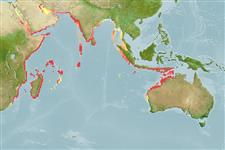>
Eupercaria/misc (Various families in series Eupercaria) >
Labridae (Wrasses) > Corinae
Etymology: Coris: Greek, kore, -es = pupil and also with themenaing of "maid" (Ref. 45335).
Environment: milieu / climate zone / depth range / distribution range
Ecologie
marien rifbewoner; diepte ? - 20 m (Ref. 9773), usually 2 - 50 m (Ref. 27115). Tropical; 24°C - 27°C (Ref. 27115)
Western Indian Ocean: southern Red Sea to Natal, South Africa and east to Sri Lanka.
Grootte / Gewicht / Leeftijd
Maturity: Lm ? range ? - ? cm
Max length : 60.0 cm TL mannelijk / geslacht onbekend; (Ref. 5213)
Dorsale stekels (totaal) : 9; Dorsale zachte stralen (totaal) : 12; Anale stekels: 3; Anale zachte stralen: 12. Terminal males reddish to lavender in color; caudal with small, dark-edged, blue-green spots, posterior margin light orange-red (Ref. 4392). Juveniles orange, head and lower part of body dark brown; 3 large, vertically elongate, broadly black-edged, white spots on dorsal part of body (Ref. 4392).
Adults found in weed, rock and coral areas; juveniles in shallow tide pools (Ref. 30573). Generally solitary (Ref. 5213). Feeds mainly on hard-shelled prey, including crustaceans, mollusks and sea urchins (Ref. 5374). Young very different (Ref. 1623).
Levenscyclus en paargedrag
Maturiteit | Voortplanting | Paaien | Eieren | Fecunditeit | Larven
Oviparous, with distinct pairing during breeding (Ref. 205).
Randall, J.E., 1999. Revision of the Indo-Pacific labrid fishes of the genus Coris, with descriptions of five new species. Indo-Pac. Fish. (29):74 p. (Ref. 33411)
Status op de Rode Lijst van het IUCN (Ref. 130435: Version 2024-2)
Gevaar voor de mens
Harmless
Gebruik door de mens
Visserij: van minder commercieel belang; Aquarium: Commercieel
Tools
Can't connect to MySQL database fbquizv2. Errorcode: Too many connections
